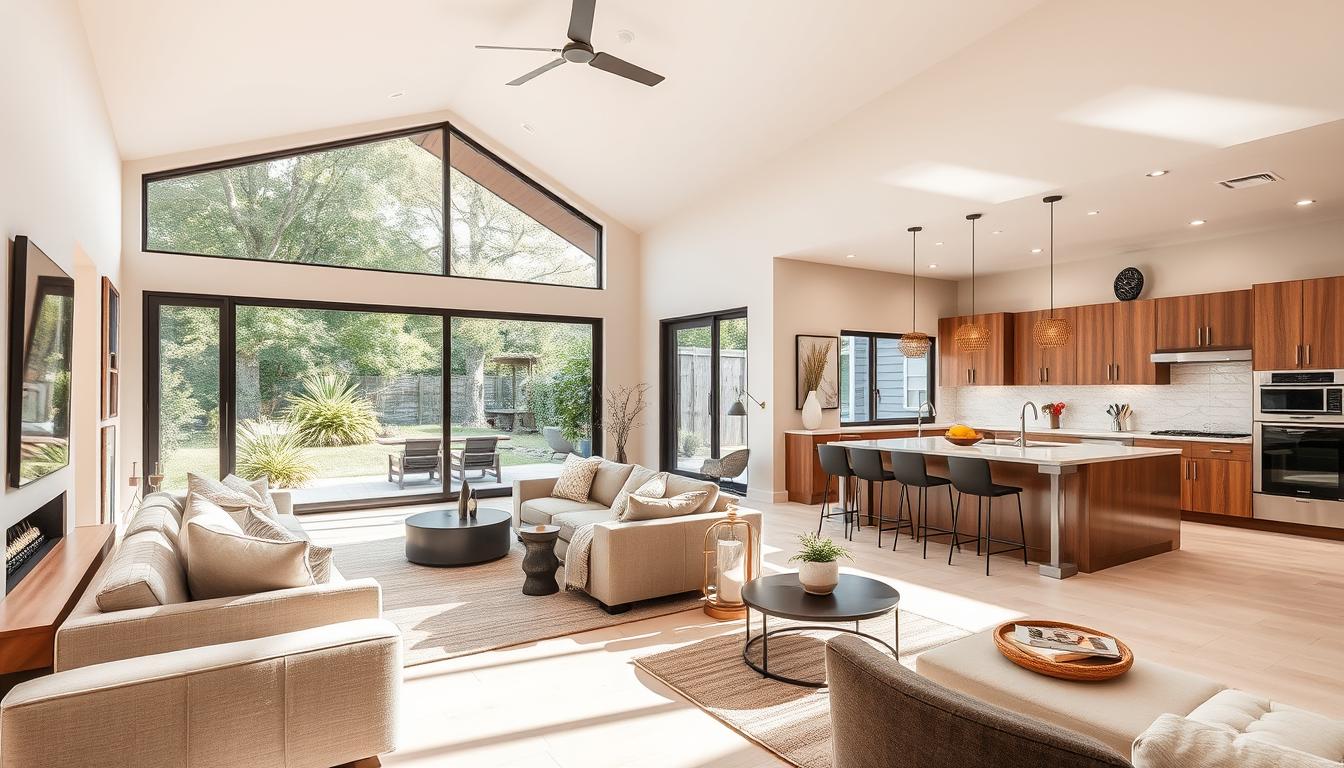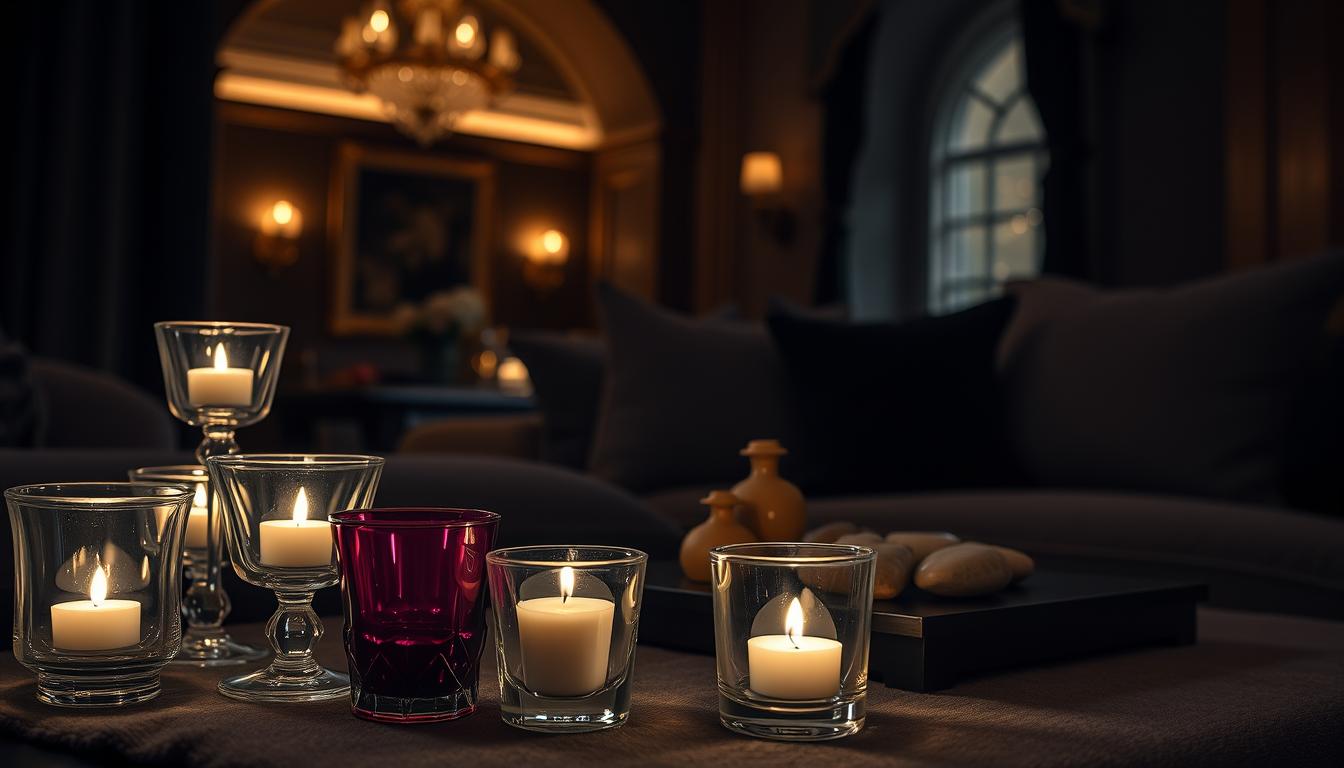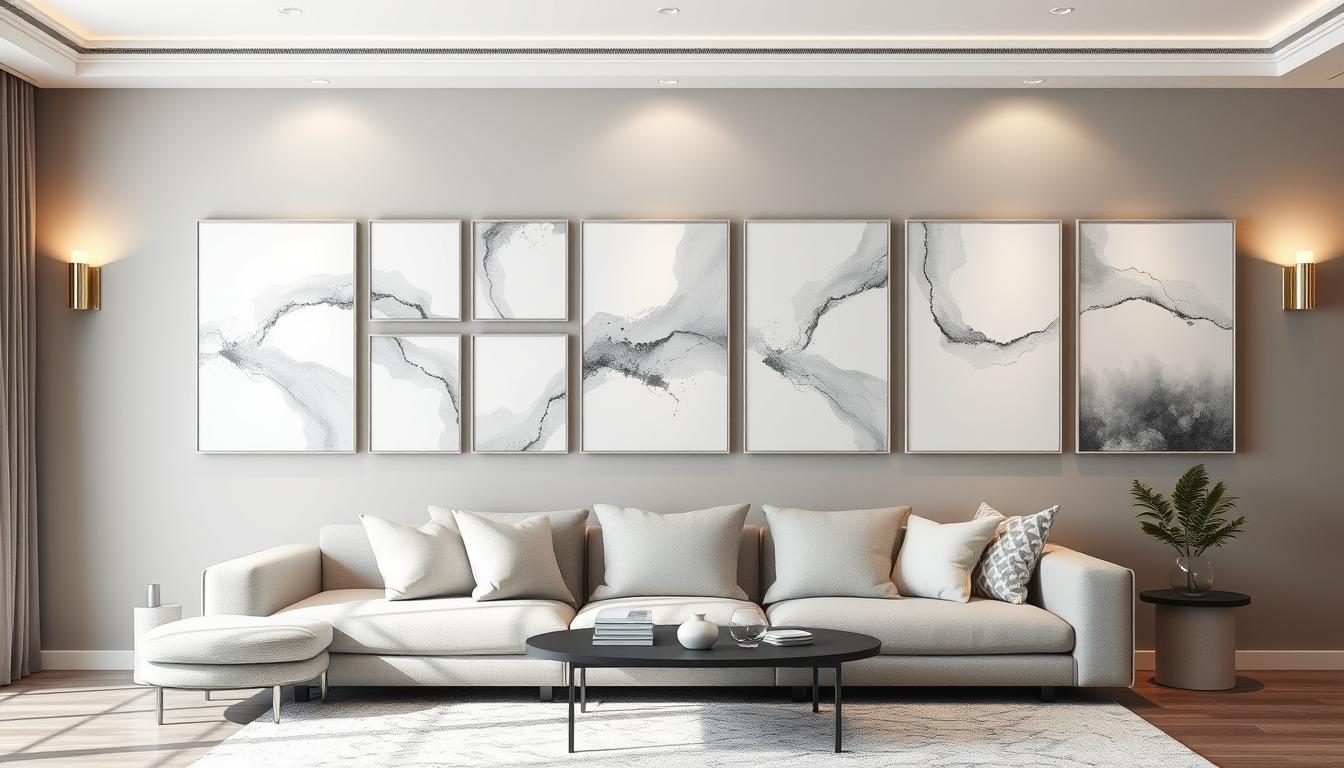Did you know a well-designed home can boost its value by up to 10%? A beautifully designed interior makes your home look great and work better. It shows off your personal style.
We think good interior design means making a space that feels welcoming and cozy. Our tips will help you make your home both beautiful and useful. With these easy tips, you can turn your home into a place you’ll always want to be.
Key Takeaways
- Understand the importance of a well-designed home interior
- Discover simple tips to enhance your home’s aesthetic appeal
- Learn how to create a functional living space
- Explore ideas to reflect your personality in your home decor
- Apply our best home decor tips to transform your living space
Understanding the Basics of Interior Design
To make your living space welcoming and harmonious, you need to know the basics of interior design. These basics are key to making your home both beautiful and useful.
The Principles of Design
The principles of design guide us in making a space look good and feel right. They include balance, proportion, emphasis, movement, pattern, unity, and contrast. Using these principles can really improve your home’s look and feel. For example, balance in a room comes from arranging furniture and decor evenly.
- Balance: Distributing visual elements to create a sense of stability.
- Proportion: Ensuring that furniture and decor are in scale with the room and each other.
- Emphasis: Creating a focal point in the room to draw the eye.
For more tips on designing your dream home, check out our article on designing your dream home. It offers more advice and inspiration for your design journey.
Color Theory in Interior Spaces
Color theory is vital in interior design, as it shapes the mood and feel of a room. Different colors can make us feel different ways. For instance, cool colors like blue and green can calm us, while warm colors like red and orange can energize us.
When using color theory in your home, remember the 60-30-10 rule. This means 60% of the room should be a main color, 30% a secondary color, and 10% an accent color. This rule helps create a balanced and pleasing color scheme.
Balancing Functionality and Aesthetics
One big challenge in interior design is mixing function with beauty. A good design should look great and also be practical and comfy. You can achieve this by picking furniture that’s both stylish and useful, and by arranging the room for easy movement and use.
- Choose multi-functional furniture pieces.
- Consider the flow of the room.
- Ensure that decorative elements do not compromise the functionality of the space.
By mastering these interior design basics, you can make a home that’s both stunning and practical. It will show off your style and meet your needs.
Creating a Cohesive Color Palette
Creating a cohesive color palette is key to a harmonious and appealing interior. A well-chosen color scheme can make your home look stylish and welcoming.
Selecting a Primary Color
Start by picking a primary color for your space. This color will be the main focus and set the mood. Think about the atmosphere you want. Calming blues and greens can make your home feel serene, while bold reds and oranges add energy.
Consider your furniture and flooring when choosing a primary color. You can also look at home interior design trends for inspiration.
Choosing Complementary Colors
After picking your primary color, choose complementary colors. These colors should enhance your primary color, creating a balanced look. The color wheel is a great tool for finding these colors. For example, blue pairs well with orange or yellow for a striking contrast.
Use the 60-30-10 rule to pick your colors: 60% primary color, 30% secondary color, and 10% accent color. This rule helps create a balanced and stylish color scheme.
Incorporating Neutrals into Your Design
Neutrals are crucial in any color palette. They balance and ground your design. Colors like beige, gray, or white prevent your space from feeling too busy. They also let your furniture and decor stand out.
| Neutral Color | Best Used With | Effect on Space |
|---|---|---|
| Beige | Earth tones, natural materials | Creates a warm, cozy atmosphere |
| Gray | Bold colors, metallic accents | Adds a touch of sophistication and balance |
| White | Any color, modern decor | Makes the space feel larger and cleaner |
By carefully choosing a primary color, complementary colors, and neutrals, you can create a stylish home interior design. It will reflect your personal style and keep up with the latest home interior design trends.
Maximizing Space in Your Home
Creating a spacious living environment doesn’t need a big home. It’s about using what you have wisely. A few simple strategies can make your home feel bigger and more welcoming.
Strategic Furniture Placement
The way you arrange your furniture greatly affects your home’s feel. Choosing the right pieces and placing them well is key to maximizing space.
- Measure your room carefully to ensure the furniture you choose fits comfortably.
- Consider the traffic flow and leave enough space between pieces for easy movement.
- Use furniture with legs or slim profiles to create a sense of openness.
Utilizing Vertical Space
Using your home’s vertical space can make it seem bigger. This can be done by using wall-mounted furniture and decor.
Here are some ways to use vertical space effectively:
- Installing shelves or storage units that go up to the ceiling.
- Using wall-mounted desks or tables to free up floor space.
- Hanging curtains or drapes high above windows to create the illusion of height.
Multi-Functional Furniture Solutions
Multi-functional furniture is great for small homes. These pieces serve more than one purpose, reducing clutter and improving functionality.
| Furniture Piece | Multi-Functional Use |
|---|---|
| Sofa Bed | Provides seating during the day and converts into a bed at night. |
| Storage Ottoman | Serves as a footrest and storage container. |
| Drop-Leaf Table | Can be used as a dining table or workspace and folded up when not in use. |
For more home interior design ideas on maximizing space, check out our additional resources.
Choosing the Right Furniture for Your Space
Furniture selection is more than just looks; it’s about making your living space functional. It’s key to pick furniture that looks good and feels comfortable.
Let’s talk about the essential pieces every room needs. For example, a living room should have a sofa, coffee table, and TV stand. These items are not just useful; they also make the room look great.
Essential Pieces for Every Room
Every room in your home needs its own must-have furniture. For instance:
- Living Room: Sofa, coffee table, TV stand
- Bedroom: Bed, nightstands, dresser
- Dining Room: Dining table, chairs, buffet or sideboard
These items help make your space both functional and welcoming.
Mixing and Matching Styles
Mixing different furniture styles can make your home unique. For example, combining modern with vintage pieces can create a special look. The trick is to find something that ties everything together, like a shared color or texture.
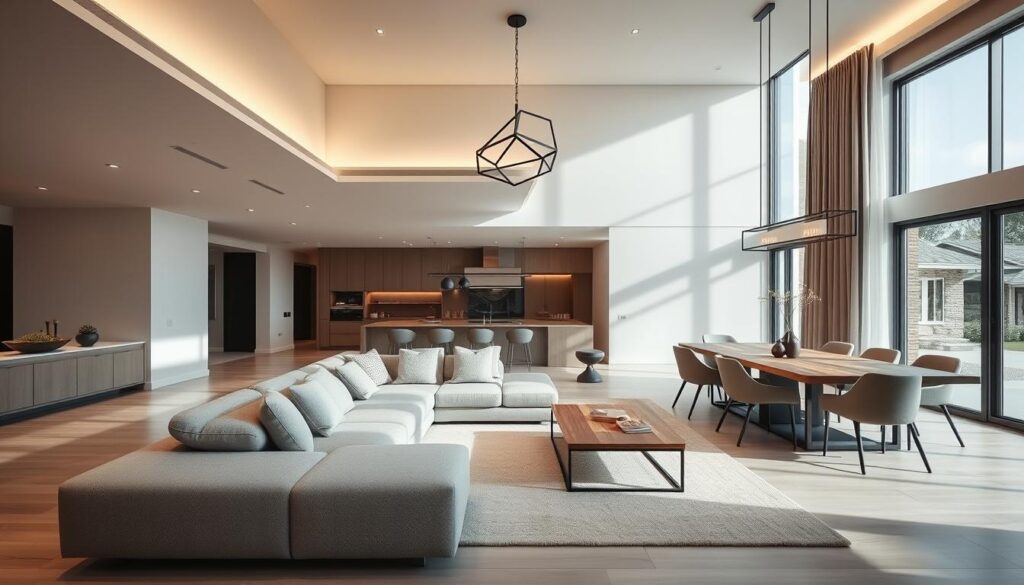
Importance of Comfort and Quality
While looks matter, comfort and quality are just as crucial. Spending more on quality furniture might seem pricey at first. But, it’s worth it for the long-term benefits of durability and comfort.
| Furniture Piece | Comfort Considerations | Quality Indicators |
|---|---|---|
| Sofa | Cushion firmness, seat depth | Frame material, stitching quality |
| Bed | Mattress firmness, bed height | Material, slat support |
| Dining Chairs | Seat comfort, back support | Construction, upholstery quality |
By focusing on both style and function, and the comfort and quality of each piece, you can make a home that’s both stunning and practical.
Lighting Design for Ambiance and Function
Lighting is a key element in interior design, making spaces come alive. It sets the mood, improves function, and affects our feelings. A good lighting plan balances different types to create a welcoming atmosphere.
Types of Lighting: Ambient, Task, Accent
There are three main types of lighting: ambient, task, and accent. Ambient lighting lights up a room, helping us move around and do things. Task lighting focuses on areas for specific tasks, like reading or cooking. Accent lighting highlights special features or objects, adding beauty and interest.
Knowing how these lights work together helps us create a rich, functional space. For example, mixing ambient and task lighting in a kitchen makes it safer and more efficient. Accent lighting can then show off the kitchen’s beauty or decorative pieces.
Layering Light for Depth
Layering light means using various sources to make a space look good and work well. This approach lets us change the lighting for different times and moods. By blending ambient, task, and accent lighting, we get a balanced scheme that supports our daily lives and adds to our home’s design.
The Impact of Natural Light
Natural light is a game-changer in interior design, making rooms better and healthier. It cuts down on the need for artificial light and brings a sense of openness. We can boost natural light by using mirrors, choosing light window treatments, and keeping windows clear. This makes our spaces brighter, more welcoming, and connected to nature.
Good lighting design is key in home interior services, changing how our spaces look and feel. By understanding lighting types, layering them, and using natural light, we can make homes that are not just pretty but also useful and cozy.
Personalizing Your Interior Design
To make your home truly yours, think about adding unique touches to your interior design. Personalization makes your space beautiful and meaningful.
One great way to personalize your space is by adding personal art and decor. This could be family heirlooms or artwork from local artists. Choose pieces that speak to you and show off your style.
Incorporating Personal Art and Decor
When picking art and decor, think about the look you want for your home. Choose items that match a theme or color scheme. For instance, vintage prints can make your living room elegant.
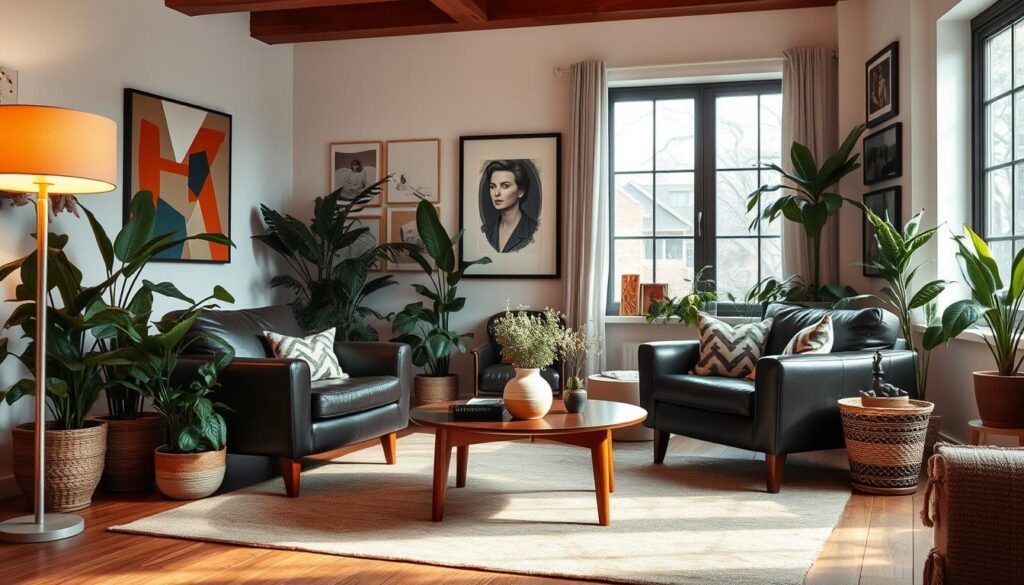
Creating a Gallery Wall
A gallery wall is a fantastic way to personalize your space. It lets you display photos, artwork, or other special items in a cool way. Start by picking a theme or frame style, then play with layouts on the floor before hanging them.
Customizing Textiles and Fabrics
Customizing your textiles and fabrics adds a personal touch. Think about custom upholstery or making throw pillows and curtains. It lets you pick the perfect colors and patterns, adding a unique flair to your decor.
By adding these personal touches, you can make your home reflect your style and personality. It becomes a more welcoming and enjoyable space for everyone.
The Role of Textures in Interior Design
Textures add depth and interest to any room. They are as important as color and furniture in good interior design. Textures give a space a tactile feel, making it more welcoming.
Mixing different textures is key to a rich atmosphere. Using velvet, linen, and wood together can balance soft and hard textures. For example, a velvet sofa with a linen armchair and a wooden coffee table works well.
Understanding Texture Combinations
Choosing the right textures is important. Think about how each texture looks and feels. Start with a main texture and add contrasts for interest.
- Begin with a dominant texture, like a neutral-toned sectional sofa.
- Add contrasting textures, like a woven basket or metallic vase.
- Balance soft textures, like throw blankets, with hard ones, like a wooden side table.
Soft vs. Hard Textures
Soft and hard textures change a room’s feel. Soft textures, like plush rugs, make a space cozy. Hard textures, like wooden floors, add sophistication.
In a living room, mix a soft area rug with wooden furniture. Metallic accents, like lighting or accessories, enhance the look.
Using Textiles to Enhance Comfort
Textiles are key to comfort. Fabrics for upholstery, curtains, and throw blankets add warmth. Choose materials, textures, and colors wisely.
- Pick materials that feel good against your skin, like cotton or linen.
- Think about the texture’s contribution to the room’s feel.
- Choose colors that match the room’s palette and enhance its ambiance.
By carefully choosing textures and textiles, we make our homes visually appealing and comfortable. This is part of our strategy for good interior design, which includes color, furniture, and lighting.
Sustainability in Interior Design
Interior design is changing, focusing more on being green. We want homes that look good and are good for the planet. This change comes from realizing how our choices affect the Earth.
Eco-Friendly Materials
Choosing the right materials is key to green design. These materials are made and sourced in ways that protect our environment. For example:
- Reclaimed or recycled materials
- Bamboo and other fast-growing, renewable resources
- Low-VOC (Volatile Organic Compound) paints and finishes
Reducing Waste in Home Renovation
Renovating homes can create a lot of waste. To cut down on this, we need to plan better. Here are some tips:
- Repurpose old furniture and fixtures
- Donate or recycle materials that are still usable
- Buy materials in bulk to reduce packaging waste
These steps help reduce waste and make renovations greener.
Supporting Local Artisans
Backing local artisans is also important for green design. It helps local economies and cuts down on carbon emissions from long-distance transport. Local crafts add a special touch to our homes.
Here are ways to support local artisans:
- Go to local craft fairs and markets
- Order custom pieces that match your style
- Choose local products over mass-made ones
By focusing on sustainability in design, we make homes that are beautiful and kind to the Earth. This benefits us and the planet, making it a good choice for everyone.
Tips for Maintaining Your Interior Design
Keeping your interior design in top shape is key to a beautiful home. A well-designed home needs regular care to stay beautiful and functional.
Cleaning and Upkeep
Cleaning regularly is vital for your modern home’s look. Dusting and vacuuming often keeps your space fresh. Make a cleaning schedule to keep your home neat and organized.
Refreshing Your Space
Seasonal updates can make your interior design feel new again. Add winter throw blankets or summer flowers to refresh your space. Follow design trends to keep your home looking current.
Staying Inspired
To stay inspired, follow interior design blogs and attend home decor events. Reading design magazines also helps. This way, you’ll always have fresh ideas for your home.

